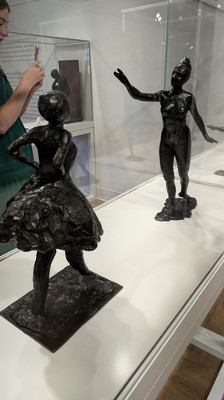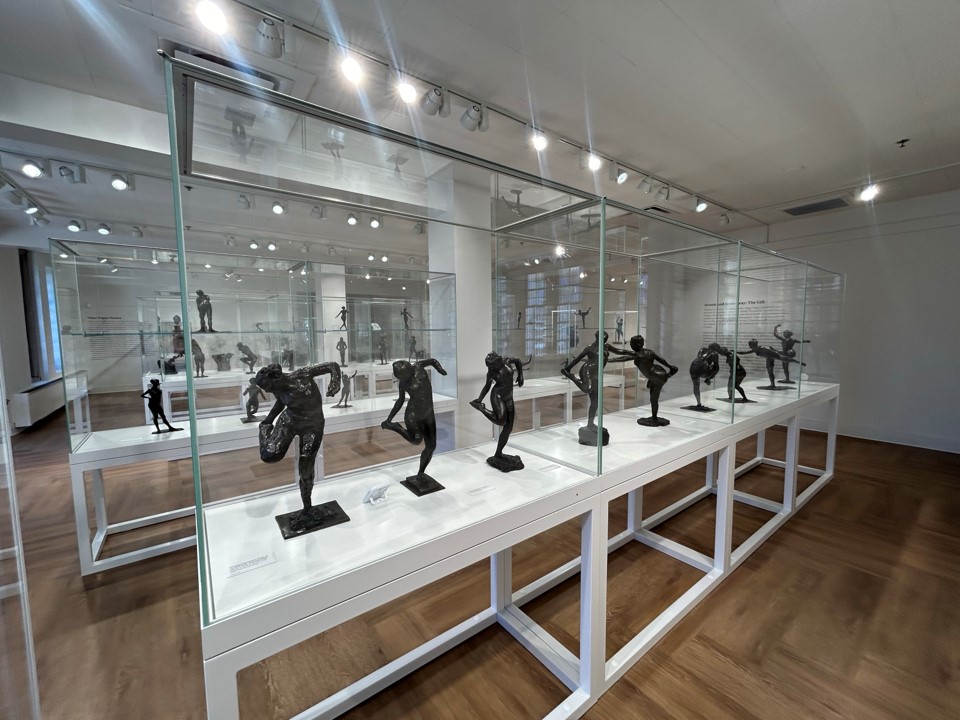The Degas Collection: A Look Behind the Glass
With the dedication of the highly anticipated Degas Collection at Purdue University’s West Lafayette campus behind us and the gallery now open to the public, we sat down with key College of Liberal Arts faculty and staff whose expertise and effort made the gallery possible.
Early on, Arne Flaten—head of the Patti and Rusty Rueff School of Design, Art, and Performance and professor of art history—and Erika Kvam, director and head curator of Purdue Galleries, knew the collection of 74 bronze sculptures by French impressionist Edgar Degas given to the University by Avrum Gray (B.S., Mechanical Engineering, 1956) would need its own purpose-built gallery. Existing gallery spaces in Stewart Center and Yue-Kong Pao Hall simply “don’t have the environmental controls to fulfill what is needed for this phenomenal collection,” Kvam said.
And those galleries serve diverse purposes, supporting a full calendar of student and faculty exhibitions in Pao Hall, and presenting a broad range of rotating exhibitions in the Stewart Center from artists across the country and around the world. “So, we needed a new space for this extraordinary gift,” Flatten added.
A Case for Space

Early in the process, Kvam knew she would need advice from Purdue’s Interior Design faculty and sent out feelers accordingly. Laura Bittner, assistant professor of practice in interior design, “who is just my absolute hero,” Kvam added, took up the call and immediately set to designing the entire gallery, from casework and lighting to presentation and accessibility.
“How do we take this space and create a visual experience where people can view the artwork and feel immersed in it without distractions,” Bittner said of the design process. “I kept returning to the Louvre for inspiration.” Within the gallery you’ll see that inspiration on display with herringbone, natural wood flooring and plain, white gallery walls with light, minimalist display cases.
The centerpiece, Degas’ iconic “La Petite Danseuse de Quatorze Ans (Little Dancer, Aged Fourteen),” will be given a custom-built case with significantly stronger environmental controls. Using top-of-the-line lighting and cleverly arranging the cases, the Little Dancer will even be visible from outside the gallery. “Whether the show is open or not,” Bittner said, “there will always be light on the Dancer. You'll be able to see her from wherever you are in the space.”
A Curator’s Perspective
Galleries Curator Kirstin Gotway said the Gray gift “is paradigm shifting for Purdue University.”
“We are especially lucky,” she continued, “to have the opportunity to display all the works in a single and purposefully designed gallery. Typically, when displayed in collections, only a small selection of the works is shown, but with Purdue’s collection we can emphasize the repetition of Degas’ work.”
She explained that in one bank of cases they’ve demonstrated how Degas continuously returned to a pose where a dancer stands on her left foot. “He clearly was fascinated by this gesture, replicating it several times with varying levels of finish,” Gotway said. “This repetition has allowed us to display the works from various angles so viewers can closely compare the figures.”
Gotway said that this is an amazing opportunity, as an art historian, to highlight works that reflect Degas’ artistic process. “At his death in 1917, several of the wax and clay models were incomplete, leaving the wire structure underneath exposed and still visible after they were cast in bronze. This provides us the opportunity to look closely at how Degas made the pieces.”
While Degas is mostly associated with ballet dancers, he also produced images of women bathing, portraits, and horses. “Displaying the entirety of bronzes produced from Degas’ working models helps us as scholars better understand the wide range of subjects that fascinated him,” Gotway explained. “He was a meticulous artist, wanting to produce work that was grounded in reality and was endlessly fascinated by the body and how it moved in space… We hope that visitors will find new and surprising facets of Degas’ oeuvre when they visit the collection.”

The Greater Impact
Valued at more than $21 million with a market value of as much as $52 million, the collection represents the largest gift in the history of Purdue’s College of Liberal Arts. “The Degas gift will provide exceptional educational opportunities for our Art Studio and Art History students, and it will also be of interest to students in the Interdisciplinary Performance program in the Department of Theatre and Dance,” Flaten said. “More importantly, the gift is transformative for Purdue Galleries. It significantly elevates the quality and breadth of our holdings, and it will bring new attention to Galleries, to the College of Liberal Arts, and to Purdue University.”
Nearly 900 students have an arts major at Purdue, and that number is growing. “It may not be the most common narrative about the university, but the arts are a significant part of Purdue’s story,” Flaten added. “Purdue has a long history of excellence in the arts, from our theatrical performances in the Mallett and Hansen Theatres, to the non-stop calendar of exhibitions in Rueff and Ringel Galleries. The design programs in the Rueff School are among the best in the country. With our new Music program, and the Department of Film and Video joining the Rueff School in 2023, the arts are flourishing at Purdue as never before.”
“The Degas gift, and our stewardship of those works, will demonstrate to other donors that Purdue is a thoughtful and responsible home for important works of art. All of this will catalyze the growth of the arts at Purdue.”
For more information, visit The Degas Collection at Purdue webpage here.